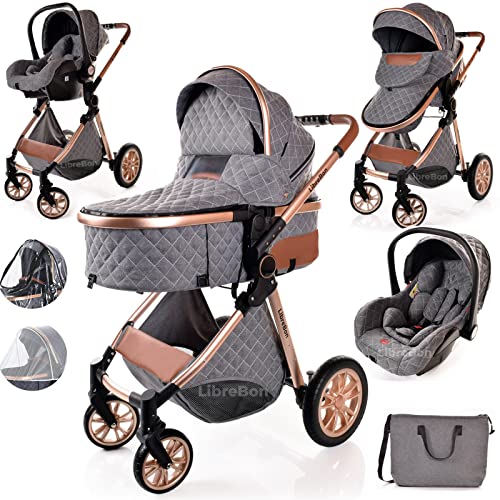Understanding Prams and Pushchairs: A Comprehensive Guide
When going into the world of parenthood, one of the most important decisions to make involves picking the ideal devices for carrying a newborn or toddler. Among the top competitors for this purpose are prams and pushchairs. Both serve the fundamental function of assisting parents and caretakers carry their kids conveniently, but they have distinct features, benefits, and use cases that set them apart. This short article aims to check out prams and pushchairs thorough, guiding prospective purchasers through their essential distinctions, advantages, and functions, and resolving regularly asked questions.
What is a Pram?
A pram, brief for "perambulator," is a kind of vehicle designed particularly for infants. It includes a completely reclining seat or bassinet, so a baby can lie flat while being transferred. This is particularly crucial for newborns whose spinal columns are still establishing. Prams typically have larger wheels, supplying a smoother trip on numerous surfaces.
Secret Features of Prams:
- Fully Reclining Seat: Allowing infants to lie flat.
- Bassinet Design: Some models come with a detachable bassinet.
- Spacious Interior: Adequate area for the child to move comfortably.
- Robust Frame: Designed to be more stable, preferably matched for city and backwoods.
Benefits of Prams:
- Comfort: Provide a relaxing area for the baby.
- Flexibility: Many can be transformed to a pushchair as the kid grows.
- Stability: Larger wheels and frames provide greater stability, particularly on unequal surface.
What is a Pushchair?
A pushchair is a light-weight alternative typically utilized for young children. Unlike prams, pushchairs normally feature a seat that can sit upright and may not use a fully reclining choice, making them suitable for older babies who can support their heads and necks. The majority of modern pushchairs featured different functions tailored towards convenience for the moms and dad and comfort for the kid.
Secret Features of Pushchairs:
- Multi-position Seats: Can accommodate sitting upright or reclining options.
- Lightweight Design: Easier to bring and steer.
- Foldable Framework: Often fold compactly for easy storage and transport.
- Larger Storage Baskets: Convenient for carrying baby essentials.
Benefits of Pushchairs:
- Lightweight and Portability: Easy to transport and keep.
- Steerability: Smaller wheels permit sharper turns.
- Availability: Easier access to older young children.
Secret Differences Between Prams and Pushchairs
| Feature | Pram | Pushchair |
|---|---|---|
| Age Recommendation | Newborn to 6 months | 6 months to 4 years |
| Seat Position | Totally reclined | Multi-position |
| Weight | Much heavier | Light-weight |
| Surface Usage | Ideal for all surfaces | Best for city/urban environments |
| Size | Larger, bulkier | Compact, easy to fold |
Choosing the Right Option for Your Needs
The decision to select between a pram and a pushchair mainly depends upon your particular way of life and your child's age. Here is a breakdown of factors to consider to assist narrow down the options:
Considerations for Prams:
- If you live in a rural area with rough surface, a tough pram may be more suitable.
- If you plan to utilize it for long strolls or outings, the comfort of a pram can be useful.
- Perfect for parents who desire a model that will comfortably support a newborn.
Considerations for Pushchairs:
- If you require something light-weight for city living or public transportation, a pushchair may be a much better fit.
- For moms and dads who want a versatile alternative for toddlers with various position settings.
- If storage area is an issue, the compact nature of pushchairs provides an option.
Typical FAQs
1. Can you use a pushchair for a newborn?
While lots of contemporary pushchairs offer reclining seats that can be used for newborns, it's generally recommended to utilize a pram or a pushchair with a bassinet alternative for adequate assistance.
2. For how long can you use a pram or a pushchair?
Prams are typically utilized for infants up to six months, while pushchairs can be suitable for children up to four years or more, depending upon the design.
3. Are prams more expensive than pushchairs?
Prams are typically more expensive due to their design, flexibility, and materials. However, expenses can vary commonly depending on brand, features, and age recommendations.
4. Is it necessary to have both a pram and a pushchair?
Not necessarily. Numerous parents choose a 2-in-1 system that integrates both functions, permitting them to adapt as their child grows.
5. What should I focus on in picking one?
Prioritize security features, convenience, weight, size, and how well it fits into your lifestyle. Check out evaluations, and test drive different models when possible.
Selecting in between a pram and a pushchair is an essential choice for new parents and caregivers. Strollers And Pushchairs have unique features that deal with different age ranges and way of lives. By comprehending these necessary distinctions, advantages, and suggestions, parents can make a more informed option that satisfies their household's requirements. Whether starting a leisurely walk in the park or navigating the pressure of city streets, the ideal pram or pushchair can improve the experience, providing safety and comfort for both the kid and the caregiver.

